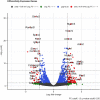SAP30 Gene Is a Probable Regulator of Muscle Hypertrophy in Chickens
- PMID: 34646299
- PMCID: PMC8502938
- DOI: 10.3389/fgene.2021.709937
SAP30 Gene Is a Probable Regulator of Muscle Hypertrophy in Chickens
Abstract
Animals with muscle hypertrophy phenotype are targeted by the broiler industry to increase the meat production and the quality of the final product. Studies characterizing the molecular machinery involved with these processes, such as quantitative trait loci studies, have been carried out identifying several candidate genes related to this trait; however, validation studies of these candidate genes in cell culture is scarce. The aim of this study was to evaluate SAP30 as a candidate gene for muscle development and to validate its function in cell culture in vitro. The SAP30 gene was downregulated in C2C12 muscle cell culture using siRNA technology to evaluate its impact on morphometric traits and gene expression by RNA-seq analysis. Modulation of SAP30 expression increased C2C12 myotube area, indicating a role in muscle hypertrophy. RNA-seq analysis identified several upregulated genes annotated in muscle development in treated cells (SAP30-knockdown), corroborating the role of SAP30 gene in muscle development regulation. Here, we provide experimental evidence of the involvement of SAP30 gene as a regulator of muscle cell hypertrophy.
Keywords: C2C12; hypertrophy; knockdown; muscle cell growth; siRNA; skeletal muscle.
Copyright © 2021 Petry, Moreira, Copola, Souza, da Veiga, Jorge, de Oliveira Peixoto, Ledur, Koltes and Coutinho.
Conflict of interest statement
The authors declare that the research was conducted in the absence of any commercial or financial relationships that could be construed as a potential conflict of interest.
Figures





References
-
- Animal QTL Database (2021). Animal QTL Database. Available online at: https://www.animalgenome.org/cgi-bin/QTLdb/index (accessed May 11, 2021)
LinkOut - more resources
Full Text Sources

